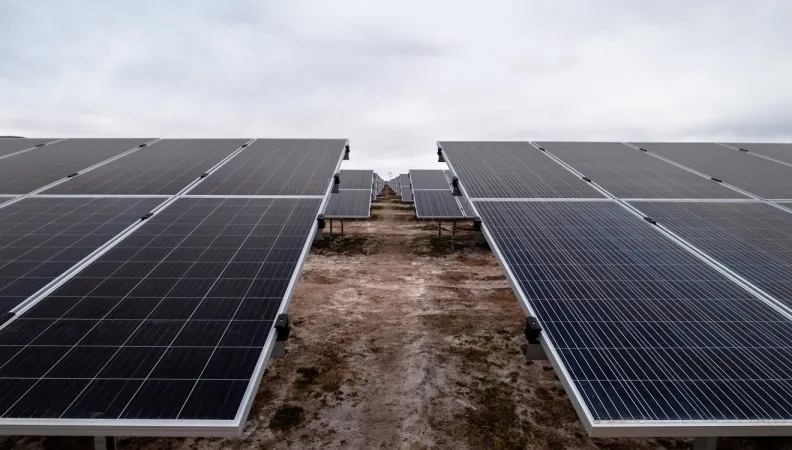Share the page
5 Projects Driving Renewable Energies Around the World
Published on

Reducing the use of fossil fuels requires massively developing low-carbon energy sources. Solar, wind, biomass, geothermal, hydropower: through its financing, AFD Group has been supporting renewable energy development for many years. A spotlight on five flagship projects led by Agence Française de Développement Group.
This article was originally published in June and updated in November, 2022
In Bolivia, one of the world’s highest photovoltaic power plants
Some 45 km from Oruro, in Western Bolivia, stands the country’s largest photovoltaic power plant in terms of installed capacity (100 MW). It is also one of the highest in the world. The Altiplano plateau, where it has been installed at an altitude of 3,730 meters, has an average level of solar radiation among the highest in the world: between 5.7 and 7 kWh per square meter per day.
The project was launched in 2016 with the financial support of AFD Group (€60 million loan), the European Union (€8.5 million grant) and the Central Bank of Bolivia (€17.5 million loan), for a total cost of €86 million.
Completed in 2021, the power plant avoids the emission of roughly 100,000 additional tons of CO2 a year. “Bolivia has engaged in a proactive policy to transform its energy mix: in 2020, renewable energies accounted for 37% of the electricity consumed in the country,” says Guillaume Meyssonnier, an AFD climate change specialist. The country’s objective is to reach 79% of the electricity consumed by 2030.
Further reading: One of the World’s Highest Solar Power Plants Leads Bolivia’s Energy Transition
In the Dominican Republic, a wind farm is supplying 150,000 households
The 25 turbines of the Pecasa wind farm, located in El Copey (Dominican Republic), 260 km north-west of the capital Santo Domingo, were commissioned in June 2019. In one of the windiest regions in the country, they today generate some 190 GWh of electricity a year, enough to supply 150,000 households and provide a livelihood for 180 workers.
Implemented by a subsidiary of the French company Akuo Energy, this wind farm with an installed capacity of 52 MW was co-financed by Proparco, AFD Group’s subsidiary for the private sector, with €12.5 million.
“This project is contributing to the Dominican Government’s strategic priority of increasing the share of renewables in the country’s energy mix to 25% by 2025. It currently stands at 15%,” says Valéry Vicini, Proparco’s Regional Director for the Dominican Republic and Haiti. This will reduce the country’s dependence on fossil fuels and avoid roughly 78,000 TEQ of CO2 emissions a year.
Further reading: AFD Group Partner of a 100% Renewable Caribbean
In Côte d’Ivoire, a power plant to recycle palm waste
Its construction has not started yet, but at its commissioning, the Biokala power plant should be the first in Côte d’Ivoire, and even in West Africa, to generate electricity from biomass. Its fuel: waste from nearby palm oil plantations, with 70% from small plantations and 30% from Palmci, a subsidiary of the Ivorian agrobusiness group SIFCA.
This power plant with an installed capacity of 46 MW is to be built in the Aboisso Department, in the south-east of the country, and will avoid roughly 180,000 TEQ of CO2 emissions a year. The project will also boost the incomes of the small-scale growers who will supply the power plant by about 20%.
The launch of the Biokala project has been made possible by the allocation of a €165 million loan and a €13 million grant by Proparco, AFD Group’s subsidiary, and the Emerging Africa Infrastructure Fund (EAIF) to Biovéa Énergie, an Ivorian-registered company owned by EDF, Meridiam and SIFCA.
Further reading: Building to Begin on One of West Africa’s Largest Biomass Power Plants
In Nicaragua, geothermal energy is taking off
What sets apart the San Jacinto geothermal power plant, located in Western Nicaragua, is that it exploits the natural heat from its subsoil to generate electricity. With an initial capacity of 72 MW, it will soon house an additional 10 MW unit, which will avoid 174,600 TEQ of CO2 emissions a year on average throughout its lifespan.
In December 2021, the Canadian company Polaris Infrastructure, which is leading this project, benefited from a €18.9 million loan from AFD Group, via Proparco. The company had been allocated a first loan of €13.2 million in 2010 to finance the previous expansion of the power plant’s capacity from 36 to 72 MW.
In Vietnam, a 2,400 MW hydropower plant
Vietnam still has a substantial share of fossil fuels in its energy mix, but has stated its commitment to develop renewable energies and set out on a low-carbon pathway. It is in this context that the country recently announced its objective of increasing the capacity of one of its hydropower plants, in Hoa Binh, located west of Hanoi, to 2,400 MW by installing two additional turbines of 240 MW each.
This expansion will contribute to replacing electricity generation from fossil fuels with an estimated volume of 488 GWh a year. This will avoid an estimated 225,000 TEQ of CO2 emissions every year. It also aims to address the anticipated increase in electricity demand in Vietnam of 6 to 7% until 2030.
AFD Group has supported the development of this hydropower plant with a €70 million loan to Vietnam Electricity (EVN). It is also providing technical assistance to the company to strengthen its environmental and social management, as well as technical expertise during the construction phase.
Further reading: Green Energy in Vietnam: Expanded Hoa Binh Hydropower Plant will Reduce CO2 Emissions
